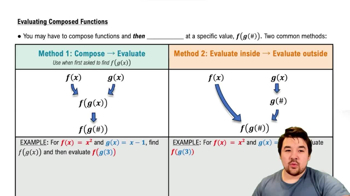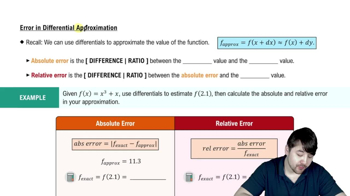Table of contents
- 0. Functions7h 52m
- Introduction to Functions16m
- Piecewise Functions10m
- Properties of Functions9m
- Common Functions1h 8m
- Transformations5m
- Combining Functions27m
- Exponent rules32m
- Exponential Functions28m
- Logarithmic Functions24m
- Properties of Logarithms34m
- Exponential & Logarithmic Equations35m
- Introduction to Trigonometric Functions38m
- Graphs of Trigonometric Functions44m
- Trigonometric Identities47m
- Inverse Trigonometric Functions48m
- 1. Limits and Continuity2h 2m
- 2. Intro to Derivatives1h 33m
- 3. Techniques of Differentiation3h 18m
- 4. Applications of Derivatives2h 38m
- 5. Graphical Applications of Derivatives6h 2m
- 6. Derivatives of Inverse, Exponential, & Logarithmic Functions2h 37m
- 7. Antiderivatives & Indefinite Integrals1h 26m
- 8. Definite Integrals4h 44m
- 9. Graphical Applications of Integrals2h 27m
- 10. Physics Applications of Integrals 2h 22m
4. Applications of Derivatives
Differentials
Problem 4.8.23
Textbook Question
{Use of Tech} Finding all roots Use Newton’s method to find all the roots of the following functions. Use preliminary analysis and graphing to determine good initial approximations.
f(x) = e⁻ˣ - ((x + 4)/5)
 Verified step by step guidance
Verified step by step guidance1
Step 1: Understand the problem and the function. We need to find the roots of the function f(x) = e^(-x) - ((x + 4)/5). A root of the function is a value of x for which f(x) = 0.
Step 2: Perform a preliminary analysis. Analyze the behavior of the function by considering its limits as x approaches positive and negative infinity, and by finding the derivative to understand its increasing or decreasing nature.
Step 3: Graph the function f(x) = e^(-x) - ((x + 4)/5) to visually identify approximate locations of the roots. This will help in choosing good initial guesses for Newton's method.
Step 4: Apply Newton's method. Newton's method uses the formula x_(n+1) = x_n - f(x_n)/f'(x_n) to iteratively find a root. Calculate the derivative f'(x) = -e^(-x) - 1/5, and use it in the formula.
Step 5: Choose initial approximations based on the graph and apply Newton's method iteratively. For each initial guess, compute successive approximations until the change is sufficiently small, indicating convergence to a root.
 Verified video answer for a similar problem:
Verified video answer for a similar problem:This video solution was recommended by our tutors as helpful for the problem above
Video duration:
13mPlay a video:
Was this helpful?
Key Concepts
Here are the essential concepts you must grasp in order to answer the question correctly.
Newton's Method
Newton's Method is an iterative numerical technique used to find approximate roots of a real-valued function. It starts with an initial guess and refines it using the formula x_{n+1} = x_n - f(x_n)/f'(x_n), where f' is the derivative of f. This method converges quickly under suitable conditions, making it effective for finding roots when the function is well-behaved near the root.
Recommended video:

Evaluating Composed Functions
Preliminary Analysis
Preliminary analysis involves examining the function's behavior to identify potential roots before applying numerical methods. This can include evaluating the function at various points, checking for sign changes, and analyzing critical points and asymptotes. Such analysis helps in selecting appropriate initial approximations for Newton's Method, increasing the likelihood of convergence.
Recommended video:

Derivatives Applied To Velocity
Graphing Functions
Graphing functions provides a visual representation of their behavior, which is crucial for understanding where roots may lie. By plotting the function, one can observe intersections with the x-axis, indicating potential roots. Additionally, graphing can reveal the function's overall shape, helping to identify regions where the function is increasing or decreasing, which aids in selecting effective initial guesses for numerical methods.
Recommended video:

Graph of Sine and Cosine Function







